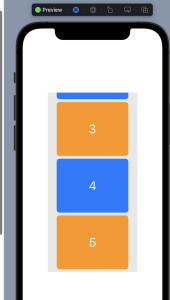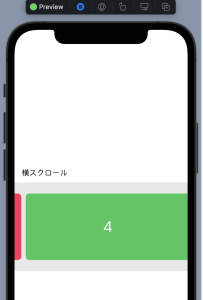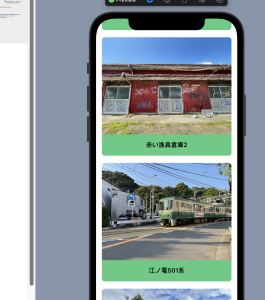LazyVGrid, LazyHGrid, GridItem, fixed, flexible, adaptive
struct ContentView: View {
let grids = Array(repeating: GridItem(.fixed(80)), count:4)
var body: some View {
ScrollView() {
LazyVGrid(columns: grids){
ForEach((1...100), id: \.self) {
num in Page(str: String(num))
.cornerRadius(8)
.frame(height: 60)
}
}
}
}
}

グリッドのサイズ指定の3つのモード
– LazyVGrid(columns:grids)のグリッドレイアウトで何列並べるか、列幅はどうするかは配列gridsで決まる
GridItem(_size: GridItem.Size = .flexible(), spacing: CGFloat? = nil, alignment:Alignment? = nil)
struct ContentView: View {
let grids = [GridItem(.fixed(30), spacing: 10, alignment: .center),
GridItem(.fixed(50), spacing: 10),
GridItem(.fixed(240))]
var body: some View {
LazyVGrid(columns: grids, alignment: .leading, spacing: 20){
ForEach(photoArray) {
item in Image(systemName: "doc")
Text(item.imageName).font(.caption)
Text(item.title)
}
}.padding()
}
}
struct PhotoData: Identifiable {
var id = UUID()
var imageName:String
var title:String
}
var photoArray = [
PhotoData(imageName: "IMG_0463", title: "台風で流された親柱"),
PhotoData(imageName: "IMG_0495", title: "横須賀ヴェルニー記念講演"),
PhotoData(imageName: "IMG_1378", title: "恋人たちの湘南平テレビ塔"),
PhotoData(imageName: "IMG_1739", title: "赤い漁具倉庫1"),
PhotoData(imageName: "IMG_1742", title: "赤い漁具倉庫2"),
PhotoData(imageName: "IMG_2233", title: "江ノ電501系"),
PhotoData(imageName: "IMG_2406", title: "茅ヶ崎漁港引き上げモーター小屋"),
PhotoData(imageName: "IMG_2407", title: "茅ヶ崎漁港第二えぼし丸"),
PhotoData(imageName: "IMG_2864", title: "相模川河口調整水門"),
PhotoData(imageName: "IMG_2909", title: "つくばエキスポセンター H2ロケット")
]
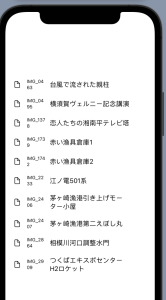
struct ContentView: View {
let grids = [GridItem(.fixed(150), spacing: 20, alignment: .leading),
GridItem(.fixed(20), spacing: 5, alignment: .leading),
GridItem(.fixed(20), alignment: .leading)]
var body: some View {
ScrollView(.horizontal){
LazyHGrid(rows: grids, spacing:20){
ForEach(photoArray) {
item in Image(item.imageName)
.resizable()
.aspectRatio(contentMode: .fit)
.cornerRadius(8)
Text(item.imageName).bold()
Text(item.title).font(.caption)
}
}.padding()
}
}
}
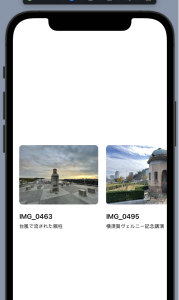
struct ContentView: View {
let grids = [
GridItem(.adaptive(minimum: 80, maximum:.infinity))
]
var body: some View {
ScrollView{
LazyVGrid(columns: grids, alignment: .leading, spacing: 10){
ForEach(1...100, id:\.self){
num in Ball(str: String(num))
.frame(width: 50, height: 50)
}
.padding()
}
}
}
}
struct Ball: View {
let str:String
var body: some View {
ZStack {
Circle()
.fill(Color.red)
Text(str)
.font(.title)
.foregroundColor(.white)
}
}
}
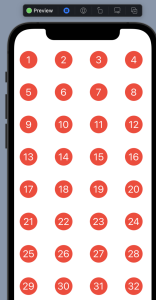
うおおおおおおお、なんか凄いことになってるな…

